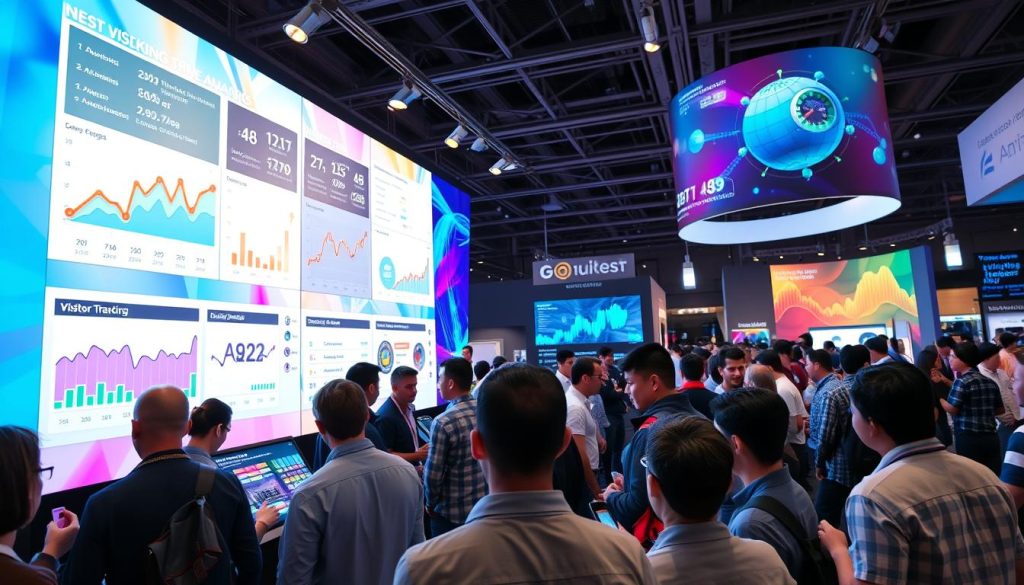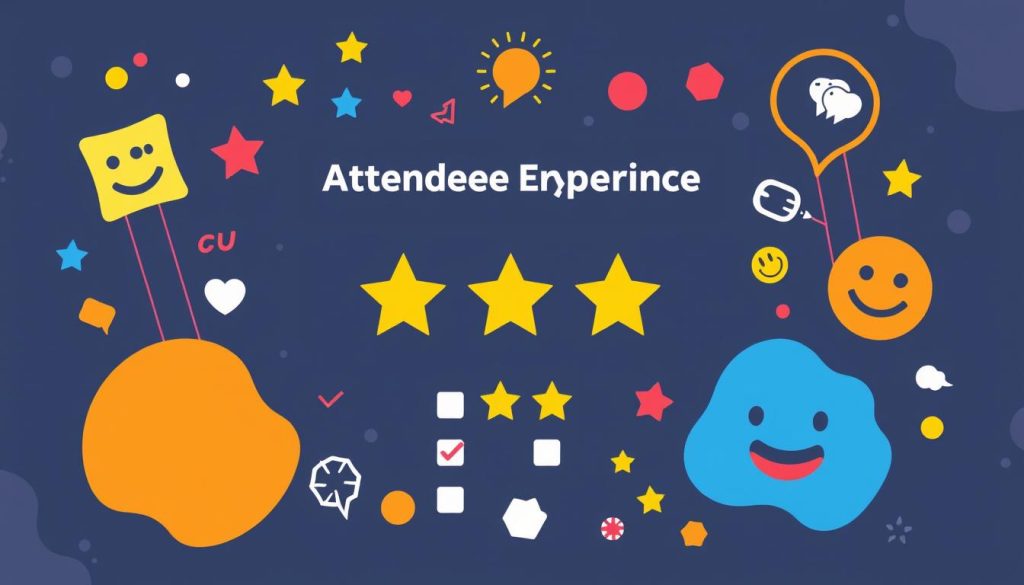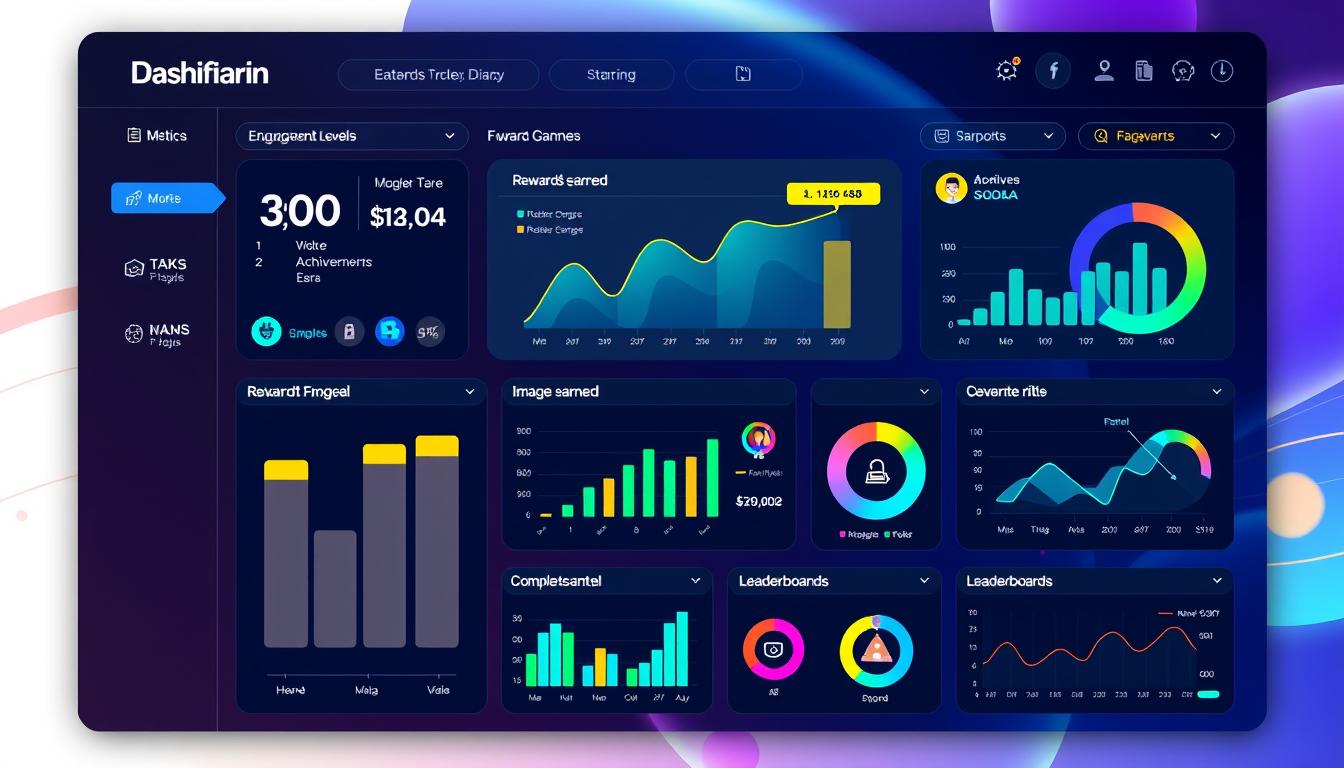Want to boost your expo game? Gamification metrics are the secret sauce! By tracking event engagement analytics, you’ll get the scoop on how well your interactive booths are performing. Expo visitor tracking gives you the power to fine-tune your strategy and create experiences that wow attendees.
Ready to level up your marketing game? Let’s dive into the world of measuring gamified strategies and see how they can transform your next event!
Key Takeaways
- Gamification metrics provide insights into booth performance
- Event engagement analytics help optimize attendee experiences
- Expo visitor tracking enables data-driven strategy improvements
- Interactive elements boost participation and lead generation
- Measuring success helps justify investment in gamified strategies
Understanding Gamification Metrics in Event Marketing
Gamification has revolutionized event marketing, making it crucial to understand the metrics that drive success. By measuring interactive booth performance and tracking lead generation, marketers can optimize their strategies for maximum impact. Let’s dive into the key aspects of gamification metrics in event marketing.
Key Performance Indicators for Gamified Events
Identifying the right KPIs is essential for evaluating the effectiveness of your gamified event. Some important metrics include:
- Participant engagement rate
- Average time spent at interactive booths
- Number of leads generated
- Conversion rate from participants to customers
Establishing Baseline Measurements
To gauge the success of your gamified events, it’s crucial to set baseline measurements. Compare your current event’s performance against previous non-gamified events or industry benchmarks. This allows you to quantify the impact of gamification on your marketing efforts.
Types of Engagement Metrics
Engagement metrics provide insights into how attendees interact with your gamified elements. Consider tracking:
| Metric | Description | Importance |
|---|---|---|
| Participation Rate | Percentage of attendees who engage with games | High |
| Completion Rate | Percentage of participants who finish games | Medium |
| Social Shares | Number of times game results are shared | Medium |
| Repeat Plays | Average number of times users play games | High |
By focusing on these metrics, you can refine your gamification strategy and boost customer engagement, ultimately leading to improved lead generation measurements and overall event success.
Setting Up Your Measurement Infrastructure
Creating a robust measurement system is crucial for tracking the success of your gamified expo strategy. By implementing the right tools and processes, you can effectively monitor expo visitor tracking and conduct thorough attendee experience evaluations.
To set up your measurement infrastructure, start by selecting a comprehensive event management platform. Omnily.io’s scheduling tools offer powerful features for managing events and tracking attendee engagement. These tools can help you streamline your expo operations and gather valuable data.
Next, integrate digital check-in systems and RFID technology to automate visitor tracking. This allows for seamless data collection on attendee movements and interactions throughout the expo. Combine this with mobile apps and QR codes to encourage active participation in gamified elements.
“The key to successful expo visitor tracking lies in seamless integration of digital tools with physical touchpoints.”
For comprehensive attendee experience evaluation, implement the following:
- Real-time feedback kiosks
- Post-event surveys
- Social media sentiment analysis
- Gamification leaderboards
By combining these elements, you’ll create a holistic view of attendee engagement and satisfaction. This data-driven approach enables you to make informed decisions and continuously improve your gamified expo strategy.
| Measurement Tool | Purpose | Data Collected |
|---|---|---|
| RFID Badges | Visitor Tracking | Movement patterns, booth visits |
| Mobile App | Engagement Tracking | Game participation, content interactions |
| Feedback Kiosks | Experience Evaluation | Real-time satisfaction scores, comments |
| Post-Event Survey | Comprehensive Feedback | Overall experience, suggestions for improvement |
How to Measure the Success of Your Gamified Expo Strategy
Measuring the success of your gamified expo strategy is crucial for improving future events and maximizing your immersive marketing ROI. Let’s explore key methods to evaluate your strategy’s effectiveness.
Quantitative Success Metrics
Track these measurable data points to gauge your strategy’s performance:
- Participant numbers
- Game completion rates
- Social media mentions
- Lead generation figures
These metrics provide concrete evidence of your event’s reach and impact. By analyzing this data, you can identify areas for improvement and create effective email sequences to nurture leads post-event.
Qualitative Feedback Analysis
Gather insights through:
- Surveys
- Interviews
- Social media comments
This feedback offers valuable perspectives on attendee experiences and helps refine your approach for future events.
Real-time Performance Tracking
Utilize event engagement analytics tools to monitor performance in real-time. This allows for quick adjustments during the expo, enhancing overall attendee experience and engagement levels.
“Real-time tracking transformed our expo strategy, allowing us to adapt on the fly and boost engagement significantly.”
By combining these measurement techniques, you’ll gain a comprehensive understanding of your gamified expo strategy’s success. This data-driven approach ensures continuous improvement and helps you skyrocket growth in your marketing efforts.
Interactive Booth Analytics and Visitor Tracking
Boosting your expo success hinges on understanding visitor behavior. By leveraging advanced analytics and expo visitor tracking techniques, you can fine-tune your booth’s appeal and maximize engagement.

Foot Traffic Analysis
Tracking foot traffic helps pinpoint peak hours and popular zones within your booth. Use heat mapping tools to visualize visitor flow and identify hot spots. This data guides strategic placement of key displays and staff to enhance interactive booth performance.
Engagement Duration Metrics
Measure how long visitors interact with specific elements of your booth. Longer engagement times often signal higher interest. Set up digital touchpoints to track interaction durations and refine your marketing strategy based on what captivates your audience most.
Conversion Path Mapping
Trace the journey from initial interaction to lead conversion. Identify which booth elements contribute most to conversions. This insight allows you to optimize your layout and refine your sales funnel for future events.
| Metric | Tool | Insight Gained |
|---|---|---|
| Foot Traffic | Heat Map Software | Popular Areas |
| Engagement Time | Digital Touchpoints | Interest Levels |
| Conversion Paths | CRM Integration | Effective Elements |
By integrating these analytics, you’ll gain a comprehensive view of your booth’s performance. Use these insights to continually refine your expo strategy and boost your return on investment.
Lead Generation and Conversion Metrics
Measuring lead generation and conversion rates is crucial for assessing the success of gamified expos. By tracking these metrics, businesses can gauge the effectiveness of their experiential marketing strategies and make data-driven decisions to improve future events.
- Number of qualified leads collected
- Lead quality score
- Cost per lead
- Lead-to-opportunity ratio
To track conversions, focus on these experiential marketing KPIs:
- Conversion rate
- Sales pipeline velocity
- Customer acquisition cost
- Return on investment (ROI)
Implementing a robust marketing automation platform can significantly enhance your ability to track and analyze these metrics effectively.
| Metric | Description | Target |
|---|---|---|
| Lead Quality Score | Assesses lead potential on a scale of 1-10 | 7+ |
| Conversion Rate | Percentage of leads that become customers | 20%+ |
| Customer Acquisition Cost | Total cost to acquire a new customer | <$500 |
| ROI | Return on investment for the gamified expo | 200%+ |
By consistently monitoring these lead generation measurements and experiential marketing KPIs, you can refine your gamified expo strategy and maximize its impact on your business growth.
Measuring User Experience and Satisfaction
Evaluating attendee experience is crucial for successful experiential marketing. By assessing user satisfaction, event organizers can refine their gamified strategies and boost engagement. Let’s explore effective methods to measure and enhance the attendee experience.
Satisfaction Surveys Development
Creating targeted surveys helps gather valuable insights into attendee preferences. Design questions that address specific aspects of the gamified expo experience. Use a mix of rating scales and open-ended questions to capture both quantitative and qualitative feedback.

User Experience Scoring Methods
Implement scoring systems to quantify attendee satisfaction. One effective approach is the Net Promoter Score (NPS), which gauges how likely participants are to recommend your event. Another useful metric is the Customer Effort Score (CES), measuring the ease of interaction with your gamified elements.
| Scoring Method | Purpose | Scale |
|---|---|---|
| Net Promoter Score (NPS) | Measure likelihood of recommendation | 0-10 |
| Customer Effort Score (CES) | Assess ease of interaction | 1-7 |
| Customer Satisfaction Score (CSAT) | Evaluate overall satisfaction | 1-5 |
Feedback Loop Implementation
Establish a continuous feedback loop to improve your gamified expo strategy. Analyze survey results and experiential marketing KPIs to identify areas for enhancement. Integrate analytics tools to track real-time performance and make data-driven decisions. By consistently refining your approach based on attendee input, you’ll create more engaging and satisfying experiences for future events.
ROI Calculation for Gamified Marketing Initiatives
Calculating the return on investment for gamified marketing initiatives is crucial for businesses looking to justify their immersive marketing ROI. By using a structured approach, companies can accurately measure the success of their experiential marketing efforts.
Cost-Benefit Analysis Framework
A comprehensive cost-benefit analysis helps determine the financial impact of gamified strategies. This framework considers both direct costs and indirect benefits, providing a clear picture of the initiative’s value.
| Cost Factors | Benefit Factors |
|---|---|
| Software development | Increased lead generation |
| Hardware requirements | Higher engagement rates |
| Staff training | Improved brand awareness |
| Marketing expenses | Enhanced customer loyalty |
Long-term Value Assessment
Evaluating the long-term impact of gamified marketing goes beyond immediate returns. Consider factors like customer lifetime value and brand equity growth when assessing overall success.
Investment Return Timeline
Understanding the timeline for returns is key to setting realistic expectations. Experiential marketing KPIs may show immediate results in engagement, but financial returns often take longer to materialize.
By carefully analyzing costs, benefits, and timelines, businesses can make informed decisions about their gamified marketing investments and optimize their strategies for maximum impact.
Data Integration and Analysis Best Practices
Mastering data integration and analysis is key to unlocking the full potential of your gamified expo strategy. By combining event engagement analytics from various sources, you can paint a complete picture of your event’s success. Start by gathering data from interactive booths, lead capture systems, and mobile apps.
To make sense of this wealth of information, use data visualization tools that turn raw numbers into easy-to-understand charts and graphs. This approach helps you spot trends and patterns in gamification metrics that might otherwise go unnoticed. Remember to clean and standardize your data before analysis to ensure accuracy.
When interpreting results, focus on how gamification elements impacted attendee behavior and engagement levels. Look for correlations between game participation and metrics like booth visits or product demos. Use these insights to refine your gamification strategy, making it more effective for future events.
Lastly, share your findings with your team and stakeholders. Create clear, concise reports that highlight key takeaways and actionable recommendations. By following these best practices, you’ll transform raw data into valuable insights that drive continuous improvement in your gamified expo experiences.
FAQ
What are the key performance indicators (KPIs) for measuring gamified expo success?
Key performance indicators for gamified expos typically include visitor engagement rates, average time spent at interactive booths, lead generation numbers, participant satisfaction scores, and conversion rates. These metrics help evaluate the effectiveness of your gamification strategy in achieving your event goals.
How can I track visitor engagement at my interactive booth?
You can track visitor engagement using various methods such as RFID technology, mobile app interactions, QR code scans, or digital check-ins. These tools allow you to measure foot traffic, time spent at different stations, and participation in gamified activities, providing valuable insights into booth performance.
What tools are recommended for measuring attendee experience?
Popular tools for measuring attendee experience include post-event surveys, real-time feedback apps, social media sentiment analysis, and in-booth feedback kiosks. Additionally, utilizing event management platforms with built-in analytics can provide comprehensive data on attendee behavior and satisfaction levels.
How do I calculate the ROI of my gamified expo strategy?
To calculate ROI, compare the total costs of implementing your gamified strategy (including development, equipment, and staffing) against the value generated (such as leads acquired, sales made, or brand awareness increase). Use the formula: ROI = (Value Generated – Total Costs) / Total Costs * 100. Consider both short-term and long-term benefits in your calculation.
What’s the best way to gather qualitative feedback on gamified elements?
Gathering qualitative feedback can be done through methods like focus groups, one-on-one interviews with participants, open-ended survey questions, and social media monitoring. Encourage attendees to share their experiences and suggestions for improvement, which can provide valuable insights beyond quantitative data.
How often should I be monitoring performance during the expo?
It’s best to monitor performance in real-time throughout the expo. This allows you to make quick adjustments to your strategy if certain elements aren’t performing well. Set up a dashboard that displays key metrics and assign team members to regularly check and report on performance throughout the event.
What are some common challenges in measuring gamified expo success?
Common challenges include accurately attributing leads or sales to specific gamified elements, measuring long-term impact on brand perception, and balancing quantitative metrics with qualitative feedback. Additionally, ensuring consistent data collection across different touchpoints and integrating data from various sources can be complex.
How can I measure the effectiveness of different game mechanics used in my expo strategy?
To measure the effectiveness of different game mechanics, track engagement rates, completion rates, and user feedback for each specific element. Compare these metrics across different mechanics to identify which are most successful. A/B testing different game elements can also provide valuable insights into their relative effectiveness.
What’s the importance of establishing baseline measurements before implementing a gamified strategy?
Establishing baseline measurements is crucial as it provides a point of comparison to assess the impact of your gamified strategy. Collect data on key metrics from previous non-gamified events or industry standards. This allows you to quantify the improvements and ROI resulting from your gamification efforts accurately.
How can I use data integration to improve future gamified expo strategies?
Data integration involves combining information from various sources to create a comprehensive view of your expo performance. By analyzing integrated data, you can identify trends, correlations, and areas for improvement. Use these insights to refine game mechanics, optimize booth layouts, and enhance overall attendee experiences in future events.


